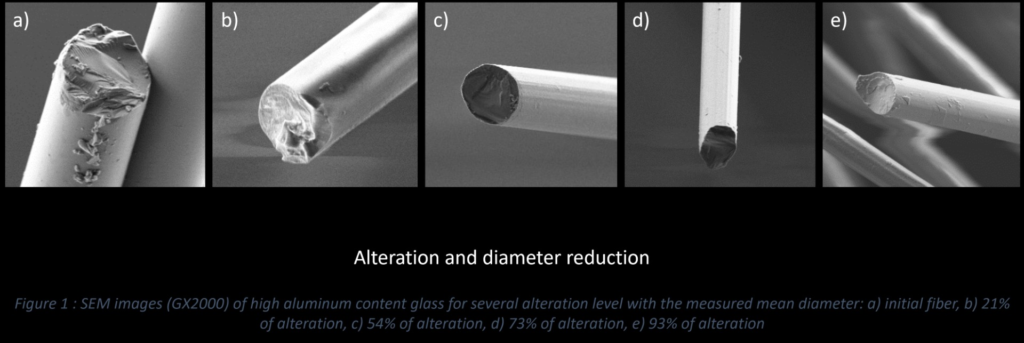Depending on the field of application, glass durability can be a key property to control (nuclear waste vitrification, pharmaceutic and food containers, insulation fibers, …). The testing conditions depend on the application: for instance, for food and pharmaceutical containers, the alteration takes place in aqueous conditions and the release of elements is monitored (release of lead from lead crystal material in the beverage for example). On the other hand, for insulation fibers, the focus is on the bio-solubility of fibers. Indeed, to be commercialized, those fibers must pass an in-vivo lung dissolution test on rats. To study this dissolution, simulated lung fluids are used. These fluids are neutral (pH 7,5) or slightly acid (pH 4,5) aqueous solutions.
This project is a CEA/Saint-Gobain collaboration and aims to understand the impact of several oxides, including aluminum oxide on the solubility of glass fibers in simulated lung fluids. In a first step, the impact of the morphology of glass samples was studied. Indeed, fibers can be tricky to produce at a lab scale. Consequently, “easy-to-produce” morphologies were evaluated. The dissolution behavior of fibers was compared to that of bulk glass, powders from crushed bulk glass, and powders from crushed fibers.
For this preliminary study, two types of glasses with high and low aluminum oxide content were studied. These samples were altered, and both the alteration solutions and the glasses were analyzed using ICP-AES and SEM, respectively. These analyses help to understand the congruent/incongruent behavior of the dissolution.
Notably, the dissolution of high aluminum content glass was proven to be congruent and follow a shrinking-core model for all studied morphologies as shown in figure 1 for the fiber samples.
This preliminary study will allow to consider the influence of the composition without taking into consideration the morphology anymore.
Abstract
Influence of glass composition and morphology on its solubility in simulated physiological fluids (SPF)
Influence of glass composition and morphology on its solubility in simulated physiological fluids (SPF)
Sarah Gandon* 12, Stéphane Gin 2, Quentin Hérault 1, Maxime Jacquemin 1, Frédéric Angeli 2, Agathe Houzet 2
1 Saint Gobain Recherche Paris, 39 Quai Lucien Lefranc, 93300 Aubervilliers, France
2 CEA Marcoule, D765, 30200 Chusclan, France
2 CEA Marcoule, D765, 30200 Chusclan, France

- Type: Poster
- Related categories: Glass alteration
